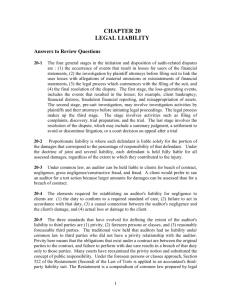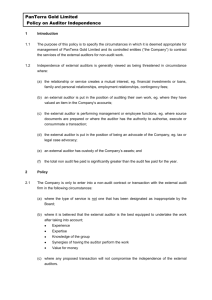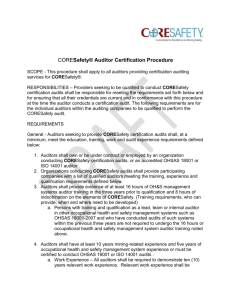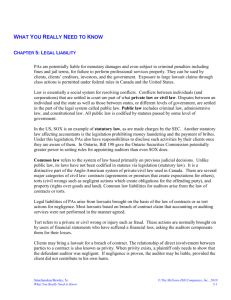Ch03revgd
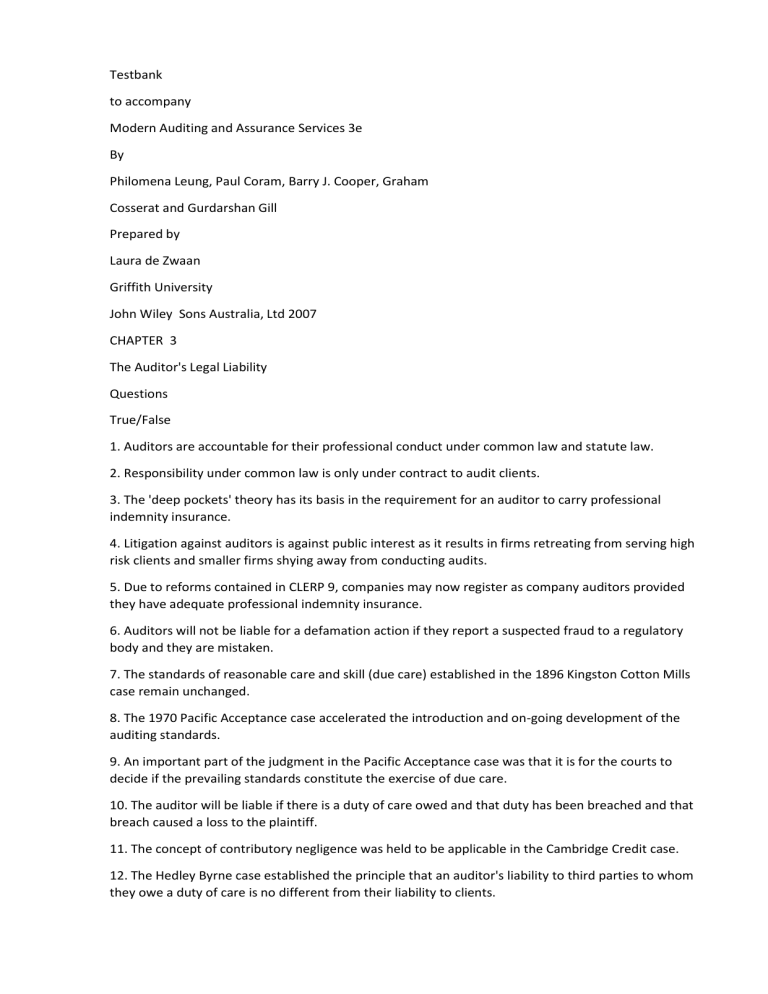
Testbank to accompany
Modern Auditing and Assurance Services 3e
By
Philomena Leung, Paul Coram, Barry J. Cooper, Graham
Cosserat and Gurdarshan Gill
Prepared by
Laura de Zwaan
Griffith University
John Wiley Sons Australia, Ltd 2007
CHAPTER 3
The Auditor's Legal Liability
Questions
True/False
1. Auditors are accountable for their professional conduct under common law and statute law.
2. Responsibility under common law is only under contract to audit clients.
3. The 'deep pockets' theory has its basis in the requirement for an auditor to carry professional indemnity insurance.
4. Litigation against auditors is against public interest as it results in firms retreating from serving high risk clients and smaller firms shying away from conducting audits.
5. Due to reforms contained in CLERP 9, companies may now register as company auditors provided they have adequate professional indemnity insurance.
6. Auditors will not be liable for a defamation action if they report a suspected fraud to a regulatory body and they are mistaken.
7. The standards of reasonable care and skill (due care) established in the 1896 Kingston Cotton Mills case remain unchanged.
8. The 1970 Pacific Acceptance case accelerated the introduction and on-going development of the auditing standards.
9. An important part of the judgment in the Pacific Acceptance case was that it is for the courts to decide if the prevailing standards constitute the exercise of due care.
10. The auditor will be liable if there is a duty of care owed and that duty has been breached and that breach caused a loss to the plaintiff.
11. The concept of contributory negligence was held to be applicable in the Cambridge Credit case.
12. The Hedley Byrne case established the principle that an auditor's liability to third parties to whom they owe a duty of care is no different from their liability to clients.
13. The Caparo case is an important UK case influencing the development of an auditor's liability to third parties in Australia.
14. In the Twomax case, the shareholders were successful in recovering losses suffered through reliance on negligently audited accounts.
15. Privity or comfort letters establish the relationship required to satisfy the criteria of proximity and reasonable foreseeability.
16. Reliance on a management representation letter is a precaution that auditors use to avoid litigation.
17. The ruling in Esanda indicates that an auditor only has to know of the theoretical possibility of the existence of a third party for a liability to arise.
18. The purpose of a privity letter is to acknowledge that no third parties are relying on the audited financial report.
19. The law of proportionate liability holds that, defendants are required to pay an amount that reflects their degree of responsibility for any wrongdoing.
20. The auditor’s duty of care to a client arises either as in a contract or in the tort of negligence.
Multiple Choice
1. environment for auditors? a. There is a growing concern that auditors are sued following business failure or fraudulent financial reporting due to their requirement to have professional indemnity insurance. b. Audit firms are exposed to unlimited liability by virtue of their incorporation under the Corporations
Act. c. Recent corporate and accounting failures, natural disasters and terrorist attacks have resulted in a
‘hard insurance market’. d. The emerging trend of multi disciplinary practices raises important issues for debate about auditor liability and conflict of interest situations. A significant number of out-of-court settlements is a feature of the on-going litigation crisis for auditors. Which of the following is suggested as a problem with such settlements? a. The profession protects itself from a lack of confidence. b. Devising ways to improve (reduce) the expectation gap become less necessary. c. The success of legally backed standards cannot be assessed. d. Provides evidence of a firm’s ability to adapt to a changing business environment. Auditors are accountable in law for their professional conduct. This accountability arises under: a. Common law. b. Statute law. c. Tort law. d. All of the above.
The so-called 'deep-pockets' theory in relation to alleged audit failures, refers to: a. The auditor being the only party left with sufficient funds to indemnify the plaintiff's losses. b. The requirement to hold a public practice certificate. c. Several widely reported business failures that resulted in significant loss to investors.
4.
5.
6. d. The coverage gap between the potential liability and available insurance cover. The litigation crisis arose as a result of business activities in which of the following time periods? a. Late 1990s. b. 1980s and early 1990s. c. 1970s. d. 1960s.
In respect of the provision of auditing services, the auditor will be liable to compensate the plaintiff if: a. A duty of care is owed to the plaintiff. b. The audit is negligently performed or the opinion negligently given. c. The plaintiff has suffered a quantifiable loss as a result of the auditor's negligence. d. All of the above.
2.
3.
7.
Which of the following is not a condition that must be met in order for a company to be registered as an authorized audit company? a. each of the directors of the company must be a registered company auditor. b. each share in the company must be held and beneficially owned by an individual or the legal personal representatives of the individual. c. a majority of the votes that may be cast at a general meeting of the company attach to shares in the company that are and beneficially owned by individuals who are registered company auditors. d. the company must be under external administration.
The more exacting auditor responsibility showing the evolving expectations in respect to the higher standards of reasonable care was set forth in the: a. London and General Bank case. b. Pacific
Acceptance case. c. Kingston Cotton Mills case. d. Donoghue v Stevenson case.
The judgement in the Pacific Acceptance case was wide-ranging and covered procedures that should exist in a normally competent audit. Which of the following is a. Promptly report material fraud or warn of suspicion of material fraud. b. Closely supervise and review the work of inexperienced staff. c. Carry out proper objective audit procedures. d. Audit the whole of the year, not just the year-end balances.
8.
9.
10. Which case laid down the fundamental auditing principles of the ‘watchdog’ role and the notion of taking reasonable skill and care? a. Kingston Cotton Mill. b. London and General Bank. c.
Pacific Acceptance. d. AWA.
11. Which case prompted the development of Auditing Standards in Australia?
a. McKesson and Robbins. b. Pacific Acceptance. c. Cambridge Credit. d. AWA.
12. The term 'privity of contract' refers to: a. The contractual relationship that exists between two or more contracting parties. b. The fact that an audit is to be performed in accordance with professional standards. c. The fact that an auditor appointed to conduct a statutory audit cannot reduce their liability by contract (s.241). d. There must be an engagement letter setting out the terms of the contract.
13. What is the term used when a failure on the part of a plaintiff to meet certain required standards of care is a factor leading to a loss by the plaintiff? a. Negligence. b. Reasonable foreseeability. c. Contributory negligence. d. Damages.
14. The passage in the judgment by Cardozo, CJ in the Ultramares case, ' …… a liability in an indeterminate amount for an indeterminate time to an indeterminate class' refers to: a. An auditor's liability to exercise due care. b. An auditor's liability to the client. c. An auditor's liability to third parties. d. An auditor's statutory liability.
15. Liability to third parties for financial injury: a. Is still not very clear. b. Has never been tested. c. Does not exist. d. Is very clear.
16. Under the Hedley Byrne principle, auditors’ liability to third parties to whom they owe a duty of care: a. Is no different from their liability to clients. b. Is more onerous than their liability to clients. c. Does not exist. d. None of the above.
17. The decision in the Caparo case (1990) reduced the duty of care of auditors to: a. all users known to the auditor. b. all users that ought reasonably to have been known to the auditor. c. the shareholders as a group. d. all users of the financial statements, except for investors.
18. concept of proximity? a. Shaddock and Associates. b. Jeb Fasteners. c. Caparo Industries. d. Twomax.
19. auditors to third parties? a. Royal Bank of Scotland. b. Lowe Lippmann. c. Esanda Finance. d.
Columbia Coffee.
20. Which of the following precautions taken by auditors would avoid or minimise the consequences of litigation? a. An engagement letter is used for all professional services offered by the firm. b. All potential clients are thoroughly investigated before acceptance. c. Professional pronouncements are fully complied with by the firm. d. All the above.
21. Which of the following statements is not reflective of matters that recent cases have emphasised:
a. Assigning appropriately competent and supervised staff to engagements. b. Adequately documenting all audit procedures. c. Adhering to independence guidelines, especially for personal relationships with clients. d. Acceptability of management representations without corroboration.
22. Litigation against auditors under the Trade Practices Act: a. Does not require the 'negligence' factors of foreseeability and proximity. b. Has been successfully used. c. Has been ruled out by the Esanda judgment. d. Is specifically excluded.
23. As a result of the rulings in Kingston Cotton Mill and the London and General Bank cases: a. overall audit quality improved. b. auditors failed to embraced new auditing techniques that would provide greater assurance. c. auditors stopped designing procedures that would detect fraud. d. auditors became more vigilant in the detection of fraud.
24. Which of the following is not a primary element of a fiduciary relationship? a. the fiduciary has undertaken to act in the interests of another. b. the fiduciary is properly certified. c. the undertaking gives to the fiduciary the power to affect the interests of the other party. d. the person to whom the fiduciary duty is owed is vulnerable to the fiduciary’s abuse of his or her position.
25. The two cases that formed the basis for most subsequent decisions as to the determination of auditor negligence were: a. Hedley Byrne and AWA. b. JEB Fasteners and Twomax. c.
Caparo Industries and Esanda. d. Kingston Cotton Mill and London and General Bank.
26. a. The auditor's liability is limited to a multiple of the fee. b. Together with the requirement for compulsory indemnity insurance and risk management strategies, appropriate protection and payment guarantees are possible. c. The statutory cap has been introduced into the Corporations Law. d. The statutory cap is only one alternative for limiting the liability of auditors.
28. Who is unable to sue the auditors under contract law? a. the directors (on behalf of the company). b. the liquidator. c. individual shareholders. d. the receiver.
29. Which of the following would be considered to be one stage removed from the privity of contract? a. the company. b. the auditor. c. shareholders. d. future creditors.
30. Which of the following would be considered to be two stages removed from the privity of contract? a. the company. b. the auditor. c. shareholders. d. future creditors.
31. In Segenhoe Ltd, the company claimed that the auditors negligence caused them to pay a dividend out of capital. What was the outcome of this case? a. the auditors were found to be liable for the dividends. b. the shareholders were ordered to return the dividends. c. the company lost as there was no causal relationship. d. the company was found to have contributed to the negligence.
32. Which of the following was the landmark case for the principle of contributory negligence? a. Kingston Cotton Mill. b. Segenhoe Ltd. c. AWA Ltd. d. Pacific Acceptance.
33. Which of the following is true regarding damages? a. damages are only available under tort. b. damages are available under tort and contract. c. damages are limited to the audit fees paid. d. damages are unquantifiable.
34. What was the outcome in the Hedley Byrne case? a. the bank was found liable for the loss. b. the bank was not found liable as no duty of care was owed. c. the advertising agency were found to have contributed to the loss. d. the bank was not found liable due to the disclaimer.
35. Which case of auditor negligence was unsuccessful as the loss was not quantifiable? a. Scott Group Ltd. b. Shaddock Associates. c. JEB Fasteners. d. Twomax.
36. Why has the reaction to the verdict in Carparo Industries generally been unfavourable? a. it is strongly thought that the loss was not quantifiable. b. the verdict appears to treat auditors more favourably than it treats other experts on whom third parties rely. c. the principle of proximity was not sufficiently established. d. it is felt that the auditors were not responsible.
37. In Australia, the common law concerning the nature and extent of an auditor’s duty of care to third parties: a. was resolved with the verdict in Esanda. b. follows the ruling in Twomax. c. has been replaced with statute law. d. remains complex.
39. Which of the following is not a precaution auditors take to avoid litigation? a. comply fully with professional pronouncements.
b. establish and maintain high standards of quality control. c. never issue a privity letter. d. maintain adequate professional indemnity cover.
40. To determine risks and potential exposure to litigation, professional accountants commonly use an inspection program. An inspection program should be flexible and could contain: a. routine inspection of all risks. b. routine inspection of a particular area of risk. c. inspections as a result of incidents or accidents. d. all of the above.
本文档下
载
自 360 文档中心, www.360docs.net
更多
营销
,
职业规
划 , 工作
简历
, 入党 , 工作
报
告 ,
总结
,
学
习资
料 , 学
习总结
,PPT 模板下
载
, 范文等文档下
载
;
转载请
保留出
处
:http://www.360docs.net/doc/info-9130ca3f0912a21614792950.html

